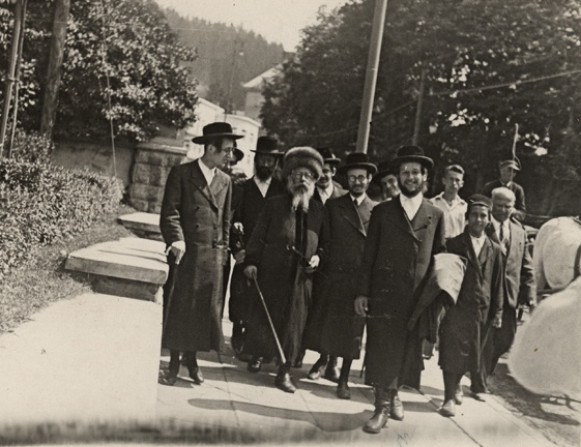Hasidism
Hasidism (from the Hebrew hasidim, meaning pious, righteous). Jewish religious movement which arose in Ukraine in the 18th century in opposition to the dogmatic and ritualistic formalism of the established orthodox Judaism. It originated as a loose network of small local groups devoted to an ascetic or ecstatic way of life, practicing their own rites, and embracing a mystical world view, which was influenced to some extent by the medieval Jewish Kaballah. These groups were led by charismatic, righteous individuals, the zaddikim. Hasidism was a popular movement that actively preached social reform and appealed particularly to the lower classes of Jewish society.
The first Hasidic leader was Israel Ba'al Shem Tov (1700–60), who was active in Podilia and traveled to other parts of the Polish-Lithuanian Commonwealth to propagate his ideas. He was widely reputed as a holy man with supernatural powers of healing and mystical visions. His doctrines and counsels were formulated in pithy sayings. Important early centers of Hasidism included Mezhyrich, Chornobyl, and Medzhybizh. The movement soon spread to Austria-Hungary, and Hasidic communities sprang up in Galicia, Bukovyna, and Transcarpathia. Hasidic schools and printing presses were set up in Korets, Zhytomyr, Berdychiv, Zhovkva, and other towns. Russia’s code for Jews, issued in 1804, legalized Hasidism by allowing Hasidic communities to build their own synagogues and choose their own rabbis. By the mid-19th century the majority of Jews in Ukraine were Hasidic and the movement was accepted by orthodox Jewry. Hasidic folklore (songs, dances, and sayings) is rich in Ukrainian themes. From Ukraine Hasidic Jews immigrated to Palestine and to the United States. In the 20th century, as Jewish life became increasingly secularized, Hasidism declined. Its opposition to the Zionist movement diminished its political influence. During the Holocaust Hasidism was completely eradicated in Eastern Europe; only a small number of its remaining adherents managed to emigrate. Martin Buber’s and A. Heschel’s philosophical systems are known as neo-Hasidism.
BIBLIOGRAPHY
Rabinowicz, Harry. World of Hasidism (New York 1970)
Mahler, Raphael. Hasidism and the Jewish Enlightenment: Their Confrontation in Galicia and Poland in the First Half of the Nineteenth Century (Philadelphia–New York–Jerusalem 1985)
Krassen, Miles. Uniter of Heaven and Earth: Rabbi Meshullam Feibush Heller of Zbarazh and the Rise of Hasidism in Eastern Galicia (Albany, NY 1998)
Vasyl Markus
[This article originally appeared in the Encyclopedia of Ukraine, vol. 2 (1988).]

.jpg)
